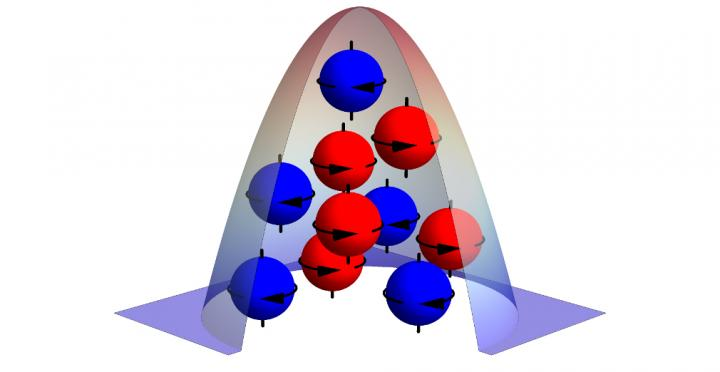May 4 2020
Observation of the universe has enabled researchers to determine that nearly 80% of its mass seems to be “dark matter,” exerting a gravitational pull but without interacting with light. Therefore, it is not feasible to observe dark matter using telescopes.
 Bose-Einstein condensate comagnetometer, formed by two distinct atomic internal states of 87Rb, which are contained in the same spatial wavefunction. Image Credit: ICFO/P. Gomez.
Bose-Einstein condensate comagnetometer, formed by two distinct atomic internal states of 87Rb, which are contained in the same spatial wavefunction. Image Credit: ICFO/P. Gomez.
The present insights into nuclear physics and cosmology indicate that dark matter could be composed of axions, which are hypothetical particles with strange symmetry properties.
Led by Morgan W. Mitchell, an ICREA Prof. at ICFO, researchers Pau Gomez, Ferran Martin, Chiara Mazzinghi, Daniel Benedicto Orenes, and Silvana Palacios, all from ICFO, describe in a new paper published in Physical Review Letters and highlighted as an Editor’s suggestion how to look for axions by making use of the exclusive properties of Bose-Einstein condensates (BECs).
If the axion exists, it would imply “exotic spin-dependent forces.” Magnetism is the well-known spin-dependent force that makes electrons to orient their spins along the magnetic field, similar to a compass needle that points north. Virtual photons carry magnetism, while virtual axions (or axion-like particles) carry “exotic” spin-dependent forces.
These forces that act on both nuclei and electrons would be generated not only by magnets but also by ordinary matter. A good way to know whether axions exist is to look and observe whether nuclei choose to point toward other matter.
A number of experiments are already looking for such forces, with the help of “comagnetometers,” which are paired magnetic sensors located in the same place. A comparison of signals from the two sensors will cancel out the effect of the ordinary magnetic field, leaving just the effect of the new force.
To date, comagnetometers could only search for spin-dependent forces that reach nearly a meter or more. A smaller comagnetometer is required to search for short-range spin-dependent forces.
BECs are gases cooled almost to absolute zero. Thanks to the superfluid nature of BECs, their constituent atoms are free to rotate without any friction for multiple seconds, which makes them highly sensitive to both new exotic forces and magnetic fields.
Moreover, BECs are very tiny, measuring only about 10 μm in size. However, developing a BEC comagnetometer necessitates solving a challenging problem: how to incorporate two BEC magnetometers within the same small volume.
As part of their study, Gomez and his collaborators could overcome this drawback by employing two different internal states of the same 87Rb BEC, where each one serves as an individual yet co-located magnetometer.
The experiment results confirm the proposed high immunity to noise caused by the usual magnetic field and the potential to search for exotic forces with considerably shorter ranges than in earlier experiments. Apart from searching for axions, the method could also enhance accurate measurements of ultracold collision physics and studies of quantum correlations in BECs.
Journal Reference:
Gomez, P., et al. (2020) Bose-Einstein Condensate Comagnetometer. Physical Review Letters. doi.org/10.1103/PhysRevLett.124.170401.